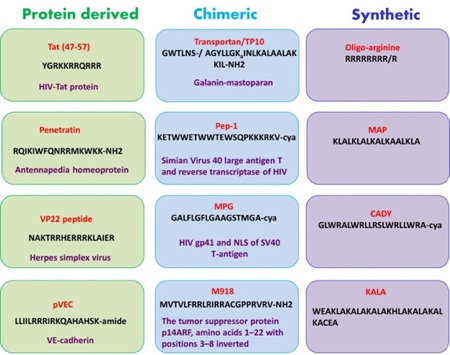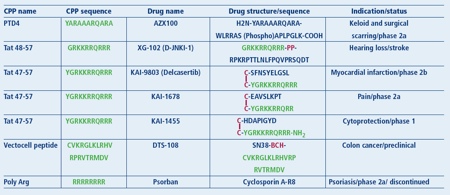The delivery of therapeutic agents into cells through cell membranes (cellular uptake) is of profound importance to the industry and has always proved to be a challenge, especially in the delivery of large molecules. The past 20 years have seen a dramatic increase in the number of drugs based on larger molecules – proteins, peptides and nucleic acids – that have the potential to circumvent the limitations of small molecules. Currently there is a demand for more efficient delivery systems to administer biologicals into specific cellular targets. Issues such as poor stability in vivo, lack of cellular uptake and insufficient ability to reach targets are challenges that have been a focus for research over recent decades.
The plasma membrane acts as a barrier to the direct translocation of hydrophilic macromolecules, preventing efficient and controlled intracellular delivery. A drug must be either highly lipophilic or very small to stand a chance of cellular internalisation and it is difficult to ascertain a generic mechanism for drug uptake. These restrictions mean that the repertoire of possible drug molecules is limited. Similarly, novel therapeutic approaches, such as gene and protein therapy, also have limited potential due to the impermeable nature of cells to peptides and oligonucleotides.
The number of known natural and synthetic peptides with cell-penetrating capabilities has continued to grow
The existing methods for delivery of macromolecules, such as viral vectors and membrane perturbation techniques, can result in high toxicity, immunogenicity and low delivery yield. A number of non-viral strategies have been introduced, such as lipid, polycationic, nanoparticle and peptide-based formulations, but only a few methods are practically used in vivo at either preclinical or clinical levels. Thus, novel efficient carrier delivery methods have to be developed to impart good bioavailability of drug molecules.
Discovery and potential of cell penetrating peptides in drug delivery: In 1988, Frankel and Pablo observed the remarkable ability of HIV-Tat protein to enter cells and translocate into the nucleus. Soon after, in 1991, the group of Prochiantz demonstrated that Drosophila Antennapedia homeodomain could be internalised by neuronal cells. This discovery subsequently led to the identification of a 16-amino acid peptide, penetratin, derived from the third helix of the homeodomain of Antennapedia.
Based on mutagenesis studies, the biological activity and the penetrating capability of Tat protein, it was found that the region between residues 47–57 (sequence: YGRKKRRQRRR) was important for cellular uptake. Since then, the number of known natural and synthetic peptides with cell-penetrating capabilities has continued to grow (see Figure 1). These peptides are known as cell penetrating peptides (CPPs), as well as protein transduction domains (PTDs), membrane translocating sequences (MTSs) and trojan peptides.

Figure 1: Examples of different CPPs that are protein derived, chimeric or de novo designed (synthetic)
Such peptides and proteins with a membrane transduction domain are derived as partial sequences from transcription factors, bacterial or viral surface proteins, toxins, amphipathic helix-forming peptides and from ligands of membrane-bound receptors or adhesion proteins. CPPs can be broadly classified as protein-derived, chimeric (derived from two or more genes which are coded for separate proteins) and synthetic, as shown in Figure 1. These short peptides with fewer than 40 amino acids share common features, such as positively charged amino acids, hydrophobicity and amphipathicity. The Tat peptide derived from HIV-Tat protein transduction domain is one of the most widely investigated cell penetrating peptides.
The discovery and the ability of these peptides to traverse the cell membrane opened up a new avenue for drug delivery. Transport of therapeutically significant biomolecules across the membrane into the cell can be facilitated by attaching them to CPPs. A major breakthrough in the CPP field came from the first proofs-of-concept of their in vivo application, by Dowdy et al, for the delivery of small peptides and large proteins and of Langel et al, for delivery of peptide-nucleic acids (PNAs) using the chimeric peptide Transportan, derived from the N-terminal fragment of the neuropeptide galanin, linked to mastoparan, a wasp venom peptide. Since then several CPPs that are able to trigger the movement of a cargo across the cell membrane into the cytoplasm have been designed.
A variety of cargo molecules have been attached to CPPs for cellular delivery. These include plasmid, DNA, oligonucleotides, siRNA, PNAs, proteins, peptides, liposomes, low molecular weight drugs, antibodies, nanoparticles, antibiotics, enzymes and enzyme substrates.
Methods of attaching CPPs to cargos: CPPs are usually connected via a covalent linkage to the cargo molecule. Proteins and peptides can be attached to CPPs through a disulfide bond (by modifying CPP and peptide/protein with cysteine) or through cross-linkers. Most CPP-nucleic acid complexes that have been proposed so far are formed through covalent bonding. Different strategies include cleavable disulfide, amide, thiazolidine, oxime and hydrazine linkages.
Short interfering RNA (siRNA) can be covalently linked to transportan and penetratin by disulfide-linkage at the 5’-end of the sense strands of siRNA to target luciferase or enhanced Green fluorescent protein (eGFP) mRNA reporters. In another study, Tat-siRNA conjugate prepared through a stable thiomaleimide linkage at the 3’-end of siRNA was delivered into HeLa cells for eGFP gene silencing.
A stable covalent linkage between the cargo and CPP is not always necessary for translocation as simple mixing of two entities was shown to be efficient
A stable covalent linkage between the cargo and CPP is not always necessary for translocation as simple mixing of two entities was shown to be efficient. The synthetic covalent bond between CPP and nucleic acid may alter the biological activity of the latter. In 1997, the first non-covalent CPP for delivery of nucleic acids, called methylpurine–DNA Glycosylase or MPG (see Figure 1), was designed by the group of Heitz and Divita1 closely followed by development of Pep-1 for non-covalent cellular delivery of proteins and peptides by Morris et al in 20012.
The groups of Wender and of Futaki demonstrated that polyarginine sequences (Arg8) were sufficient to drive molecules into cells and proposed their uptake mechanism involving a bidentate hydrogen-bonding interaction between the guanidinium group of arginine residues and phosphate group in the membrane. Thus, a new non-covalent strategy requiring no chemical modification with short amphipathic CPPs, like MPG and Pep-1, as carriers has been successfully applied for delivery of cargos.
These non-covalent conjugates are formed through either electrostatic or hydrophobic interactions. With this method cargos such as nucleic acids and proteins could be efficiently delivered while maintaining full biological activity. MPG forms highly stable complexes with siRNA with a low degradation rate and can be easily functionalised for specific targeting, which are major advantages compared with the covalent CPP technology.
CPP-drug conjugates in clinical trials: Research and clinical studies on the transport and delivery of therapeutics into cellular targets using cell penetrating peptides has progressed well in recent years. In a transport feasibility study Tat was shown to be able to shuttle a N-(2-hydroxypropyl) methacrylamide (HPMA) copolymer and the doxorubicin into a human ovarian carcinoma cell line. The same drug and benzylpenicillin fused to the CPP SynB1 were able to cross the blood–brain barrier as shown by an in situ rat-brain perfusion technique after intravenous administration.
Several companies started work on clinical development of CPPs, for topical and systemic administration of different therapeutic molecules. The first CPP clinical trial was initiated by Cellgate, for topical delivery of cyclosporine linked to polyarginine and entered phase II trials in 2003 for the treatment of psoriasis under the commercial name of PsorBan. This is an example of local application of CPP-drug conjugate (Local CPP-mediated delivery). However, despite an efficient uptake of the chimera, the release of the free drug was not rapid enough to compete with clearance.

Table 1: CPP based drug delivery: CPP-Drug conjugates entered clinical trials so far
A list of CPP-based drugs that entered clinical trials is shown in Table 1. In all of these cases, therapeutic agents are covalently linked either directly or through a linker to the CPP carrier. In KAI-9803, KAI-1678 and KAI-1455 the cargo peptide is attached to the Tat peptide via a disulfide bond conjugation by modification with an additional cysteine at the N-terminus of both entities.
The peptides SFNSYELGSL and EAVSLKPTC areδd protein kinase C (dPKC) and e protein kinase C (ePKC) specific inhibitors respectively, and HDAPIGYD is a eεPKC activator peptide. Capping the carrier peptide portion (Tat) in the case of KAI-1455 was shown to increase the plasma half-life of the peptide composition. DTS-108 is a Vectocell peptide-SN38 prodrug generated by chemical coupling of the 10-hydroxyl group of SN38 via a heterobifunctional cross-linker to the Vectocell peptide DPV1047 (CVKRGLKLRHVRPRVTRMDV). This linker results in the generation of an ester bond between the peptide and SN38.
The future for CPPs
Extensive research on the design and in vivo applications of cell penetrating peptides over the past 20 years has demonstrated the potential of these special peptides in molecular medicine. With the aid of CPPs, delivery of therapeutic biomolecules such as oligonucleotides and proteins can be better managed in terms of efficiency, cytotoxicity and biocompatibility. CPPs can associate with an extensive range of cargo types either via covalent linkage or non-covalent interaction. Unlike viral vectors, CPPs do not have the capacity to integrate the genetic material they deliver, and therefore there has been no evidence for CPP use resulting in oncogene activation.
One of the limitations of CPPs is the non-specific cellular uptake, thereby limiting the drug delivery to specific cellular targets such as tumour cells
One of the limitations of CPPs is the non-specific cellular uptake, thereby limiting the drug delivery to specific cellular targets such as tumour cells. Fortunately, in recent years some CPPs have shown high affinity for specific cell types or intracellular destinations. A recently discovered CPP known as ‘crotamine’ has shown unusually high affinity for actively proliferating cells. Another example lies with MPG, a synthetic CPP derived from the SV40 virus. Originally designed for nuclear delivery of siRNA, it has recently been altered to target the cytoplasm.
Recently ‘activatable’ CPPs were introduced to address the problem of tissue non-specificity of CPPs. Constructs have been described that are ‘activated’ either outside or inside the cells. Activatable cell penetrating peptides (ACPPs) are polycationic CPPs whose adsorption and cellular uptake are minimised by a covalently attached polyanionic inhibitory domain. Cleavage of the linker connecting the polyanionic and polycationic domains by specific proteases (tumour associated matrix metalloproteases) dissociates the polyanion and enables the cleaved ACPP to enter cells.
Another solution to the problem of cellular non-specificity of CPPs will be to take advantage of several known cell targeting peptides to design new peptides by combining both targeting and internalisation properties.
Bibliography
1. Heitz F, et al., Br J Pharmacol. 2009; 157:195–206.
2. Morris MC, et al., 2008; Biol Cell 100: 201–217.
3. El-Andaloussi S, et al., Curr Pharm Design. 2005; 11: 3597–3611.
4. Deshayes S, et al., Cell Mol Life Sci. 2005; 62:1839–1849.
5. Simeoni, F, et al., Methods Mol Biol. 2005; 309: 251–264.




